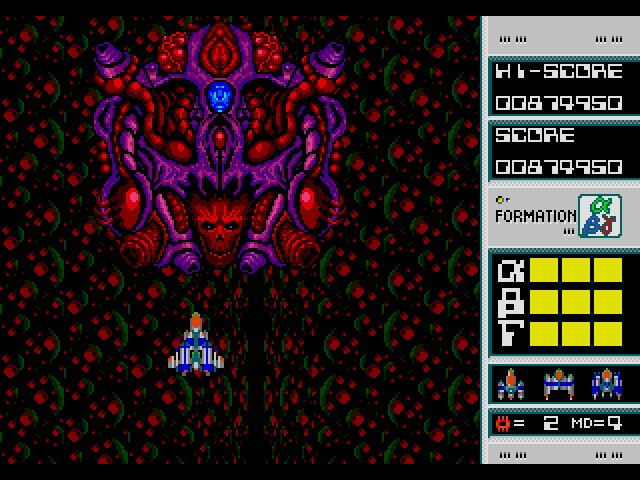
PLAYERS: 1
PUBLISHER: Namco
DEVELOPER: Namco (port by TOSE?)
GENRE: Shoot-em-up
RELEASE DATE: 12/18/90 – (JP)
In 1981, Namco created Galaga as a simulator for a potential alien bug invasion. The machines were only supposed to be sent to military around the world, but the president of Namco ordered that some cabinets be released for commercial use to recoup expenses. The simulator became a hit, but many governments were confused. Was Galaga a training exercise for soldiers or just another arcade game? In the wake of the simulator’s overwhelming success, Namco failed to clarify. Today, Galaga is seen as a darling from the golden age of arcade games, and while several sequels have been made to capitalize on the original’s success, the game’s initial purpose has long been lost.

Nine years later, Namco created yet another bug-destroying simulator, Dangerous Seed. Instead of alerting the entire world as they did with Galaga, they limited the simulator’s release to the company’s home country of Japan. While the reasons for Namco doing this are unclear, the results of their actions were sadly predictable: few saw the game, few played it, and few cared about its message. Nearly three decades after its release, and with no alien bug invasion in sight, is Dangerous Seed‘s message worth conveying to a global audience, or does it play as wacky old propaganda from a company whose biggest successes lay in the corpses of untold space bugs?

Set in the not-too-distant future, Dangerous Seed tells the story of Moon Diver, a ship that’s been chosen to quell an oncoming alien (bug) invasion from the base, Danger Seed. Your mission is a twelve-level endurance run across the galaxy, spanning entire planets like Jupiter and Uranus to the heart of the Danger Seed itself.

Moon Diver has three parts to it, Alpha, Beta, and Gamma. In the opening cutscene, all three parts separate from each other, and you begin the first part of the game as the Alpha portion only. Over the course of several levels, you reunite with Beta and Gamma to become the almighty Moon Diver. Once reunited, you can alternate between the three parts with the ‘C’ button. Each part has its own life bar, shot pattern, and bomb type. Three weapons – Wave, Laser, and Normal – are available and can be upgraded several times via power-ups hidden within enemies. There are also speed boosts, bombs which cover generous portions of the screen, and options which automatically circle around you and prevent projectiles from hitting the ship.

At first the insect menace doesn’t seem so threatening. Enemies are petite and few in number, and the enormous bug bosses can be overcome with little trouble. Once Beta and Gamma reattach to Alpha, however, you sail towards the planets where the true threat emerges. Enemies of all sizes now appear in bursts and spew multiple projectiles instead of one or two. Moon Diver is stronger, but also bigger, leaving him more vulnerable to getting hit. Your mission turns from a leisurely stroll to a fight for survival.

The final planet is a boss rush where you have to tackle several bosses in a row. You’re provided speed boosts, power-ups, extra bombs, but rarely health. It feels like the end of the game, but then, the Danger Seed base appears, four additional levels that are short and relentless. In one level, you appear to be trapped within some being’s insides. The pink sides undulate and hurt you if you touch them, so you have to travel gingerly down the middle of the stage, avoiding both the sides and any stray creatures that emerge in the middle. In another level, little orbs with pincers chase you around the screen, while other enemies materialize out of nowhere in front of you. Only a steely-eyed vigilance will help you destroy the Danger Seed in full.

When judged solely as a shoot-em-up, Dangerous Seed is a polished take on the tried-and-true “destroy things in space” trope that’s existed since the genre’s inception. Moon Diver’s controls are fluid and graceful. The soundtrack carries a melancholic, determined weight similar to early Mega Man. The sole new idea here – one large ship split into three parts that come back together over time – is a unique one, and the twelve missions, though occasionally long and trying, get more interesting as you progress.

I can see why Dangerous Seed failed in its mission of informing the Japanese populace of the impending alien bug invasion. The simulator feels like it takes place in an ostensible future, not our current day where wars in space are a mere pipe dream. Considering we have yet to prove the existence of any alien, it’s hard to comprehend the thought of giant pink space bugs. Still, whether you believe an alien bug invasion is just over the horizon or whether you believe they are the figment of our increasingly darkened imaginations, with Dangerous Seed, Namco makes the prospect of fighting them off incredibly appealing.
B


5 replies on “Dangerous Seed (Mega Drive, 1990)”
Who knew this got so interesting-looking later in the game? I played a few short bursts of this a while ago and thought it seemed competent but dull. Your screenshots have really piqued my interest though.
“Competent but dull” was my initial thought as well, but the game really opens up after level 4 or so
Never played it, but that box art may be one of the best on the Mega Drive.
It is pretty awesome!
Well, color me misinformed. As the others, I always thought it looked and felt boring in the beginning of the game. Little did I know how much things apparently improved over the course of the game. The first couple levels are the definition of mediocrity, so I never bothered much beyond that. I guess I’ll have to give this one another look. Also, the box art is so metal – love it!